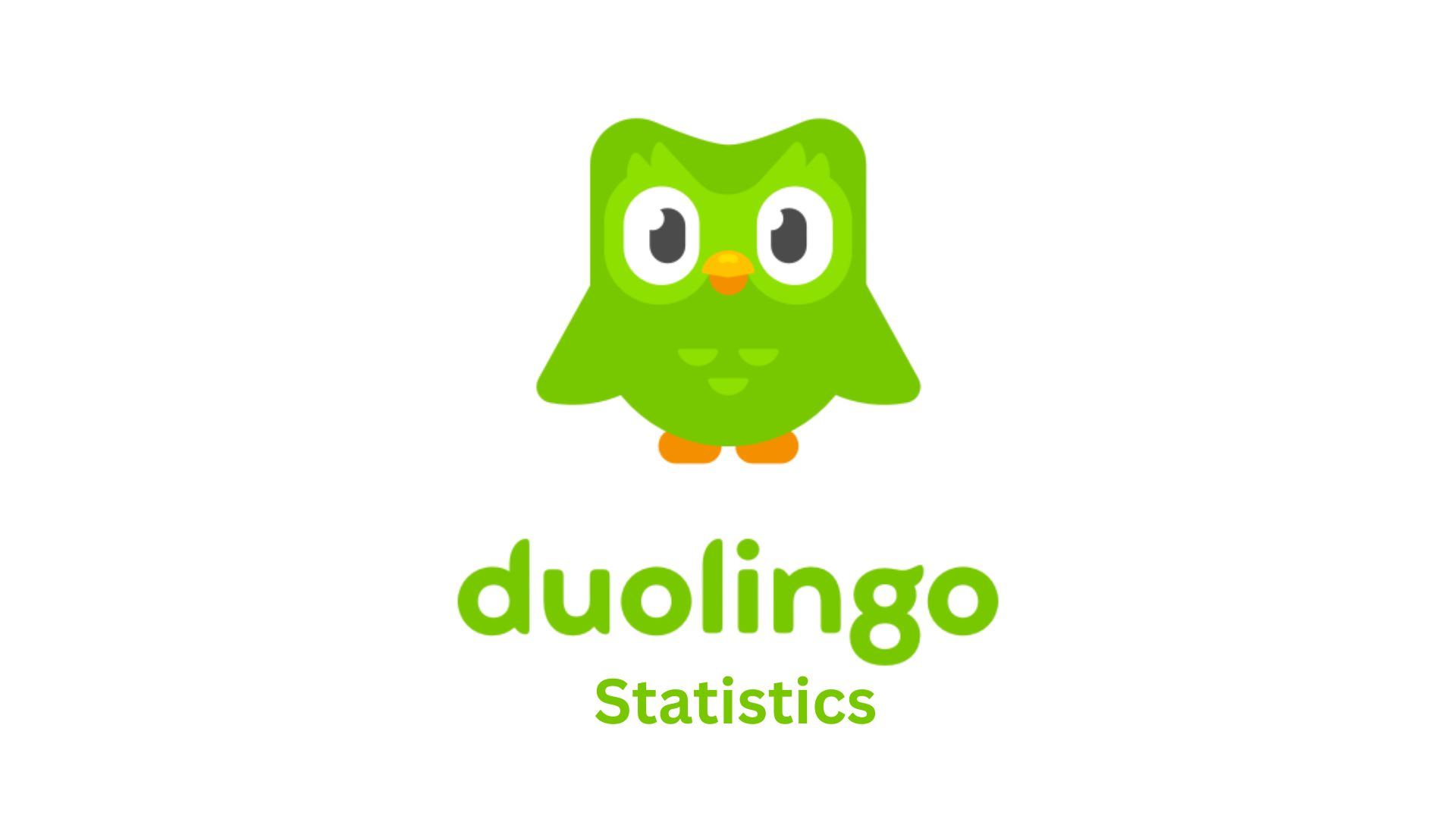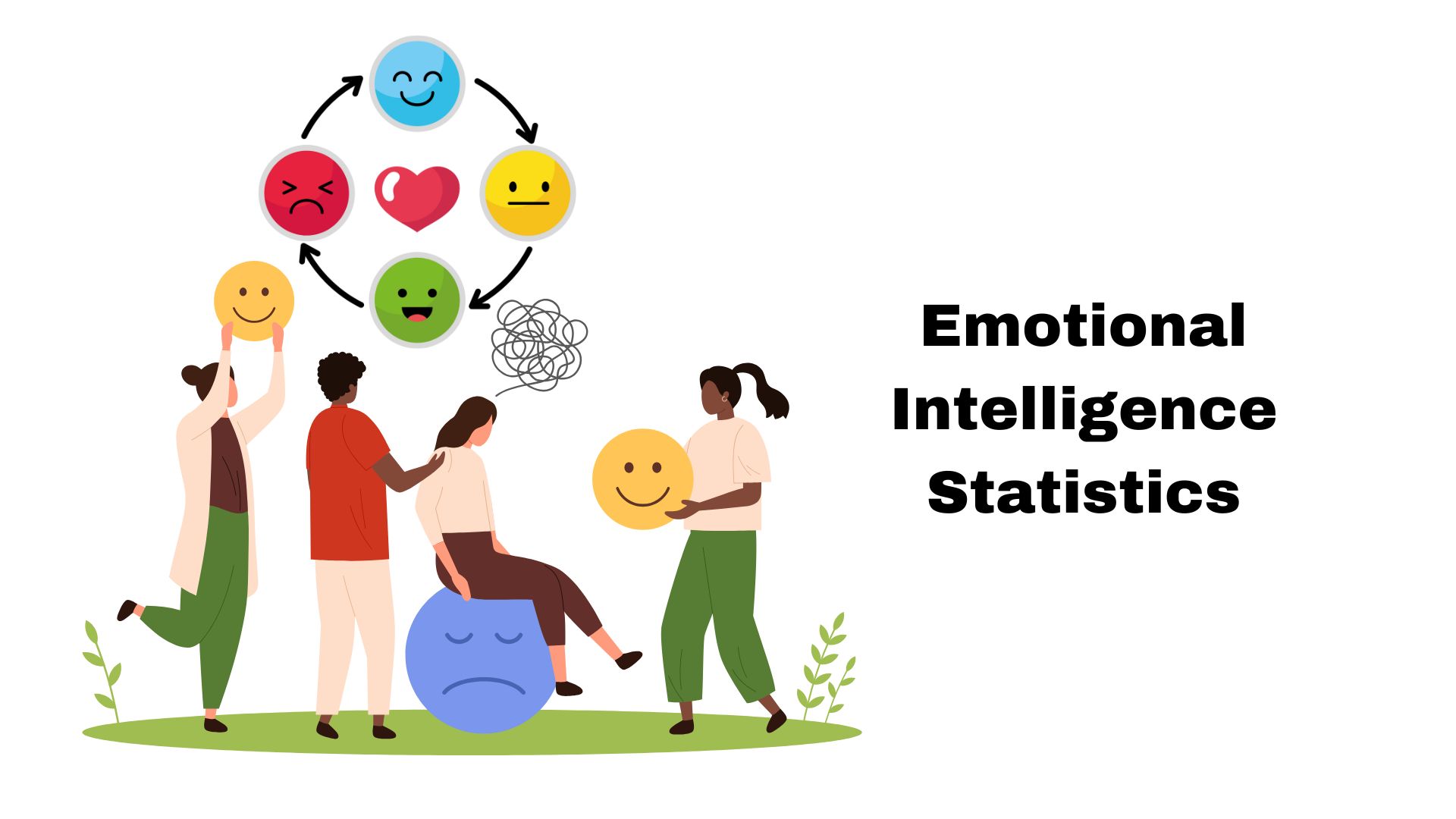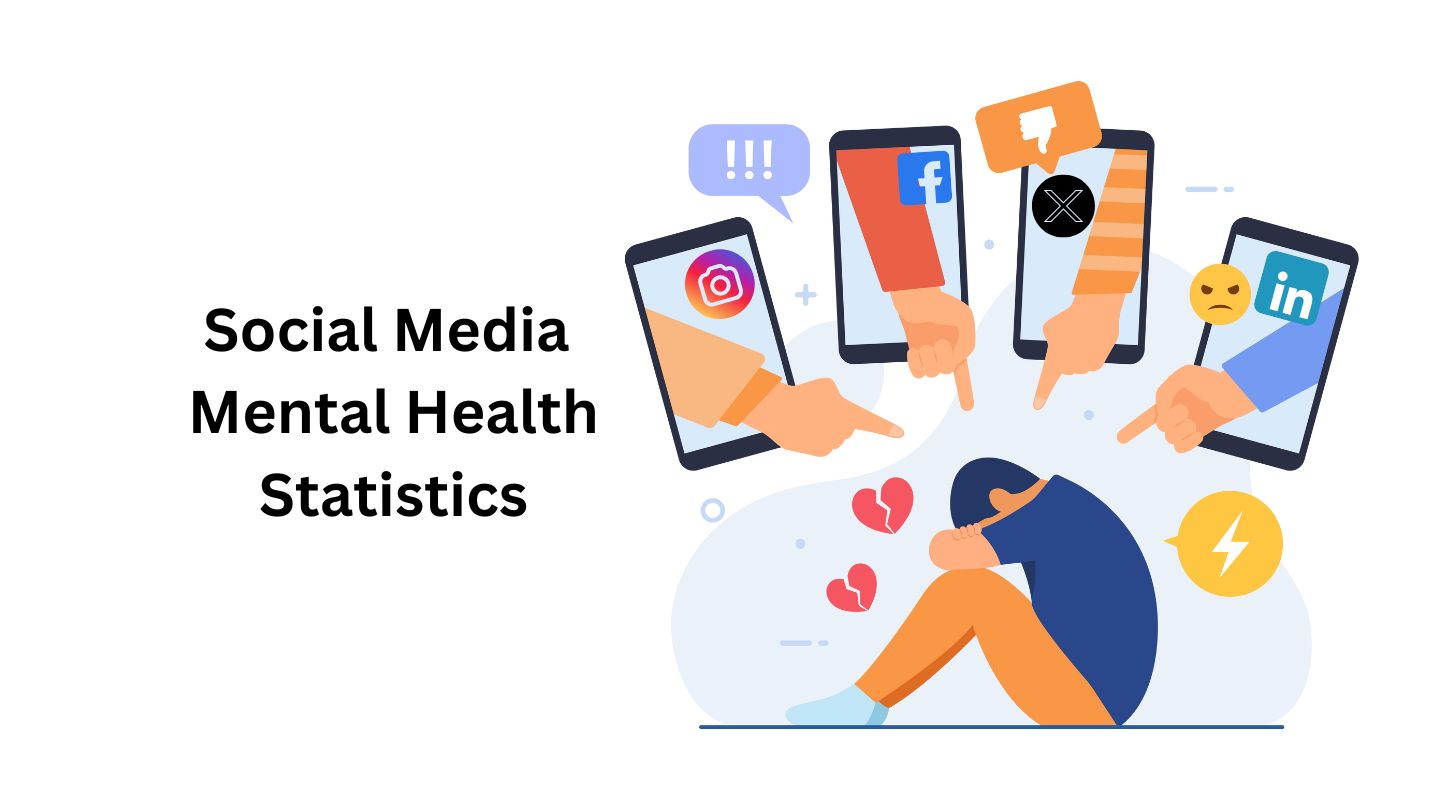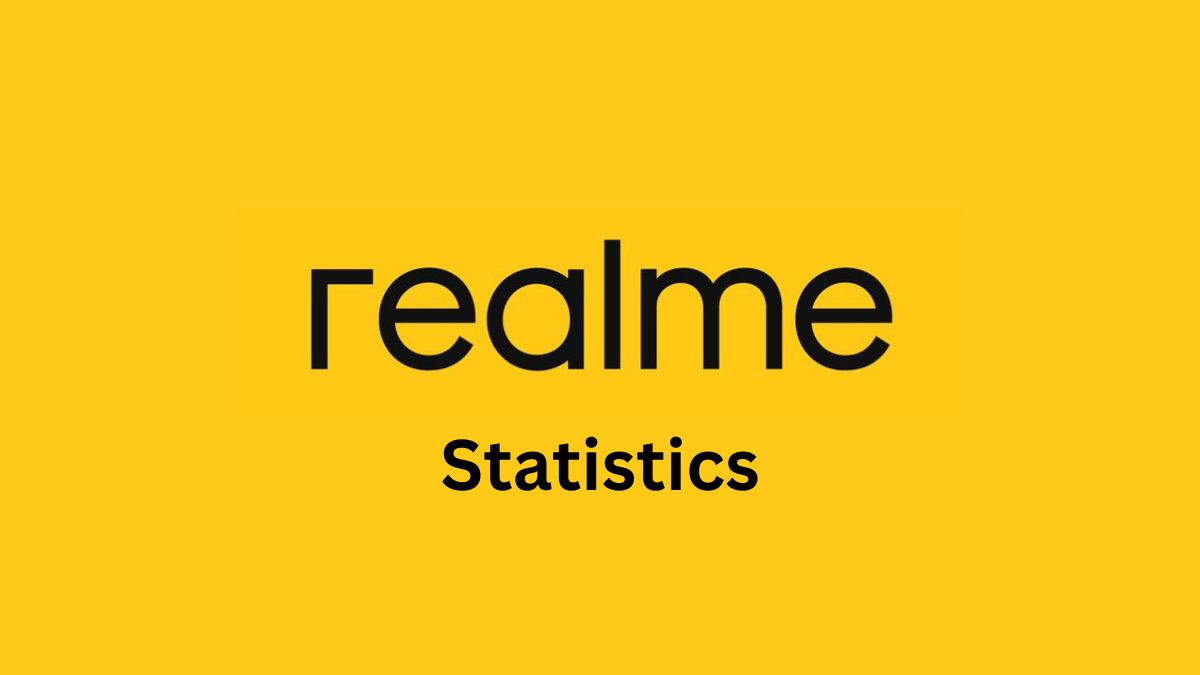How Many People Drink Coffee Statistics And Facts (2025)
Updated · Jul 16, 2025

Table of Contents
- Introduction
- Editor’s Choice
- Share of U.S Coffee Drinkers By Level/Frequency of Coffee Consumption
- Coffee Consumption By Region
- Favorite Coffee Brands
- Country With High Coffee Consumers
- Coffee Consumption Frequency
- Coffee Consumption Per Day
- Preferred Ways of Making Coffee By Generation
- Global Coffee Production
- Global Coffee Spending
- Consumption of Coffee-Based Drinks/Dishes
- Average Coffee Price
- Conclusion
Introduction
How Many People Drink Coffee Statistics: Coffee is more than just a beverage-it’s like some ritual all over the world, an essential ingredient of a culture, and course, a thriving industry. The 2024 year sees the consumption of coffee still climbing, aided by changes in consumer behavior, shifts in the economy, and surging interest in specialty brewing.
We will look into some of the latest How Many People Drink Coffee statistics worldwide and try to understand who drinks coffee, how much coffee they drink, and the economic revenue generated by this beloved beverage.
Editor’s Choice
- Over one billion people drink coffee each day; more than 2.25 billion cups of coffee are consumed daily across the globe.
- 73% of Americans claim to have coffee daily, with 60% of them drinking 1-2 cups per day; 36% consume 3-5 cups.
- Europe is the largest coffee market (53.7 million 60-kg bags), while the Asia-Pacific region is the fastest-growing market.
- Starbucks is often regarded as the best coffee brand in the United States, followed by Dunkin’ and Folgers.
- The United States imports an estimated 3.4 billion pounds of coffee each year and is also the largest importer in the world, with a value of more than US$8 billion, mainly from Brazil and Colombia.
- Baby Boomers and their drip coffee; Gen X with their Keurig; Instant for some Millennials; French press for Gen Z, with whipped coffee in tow.
- Countrywise, Brazil is the biggest coffee producer with 62.6 million bags, followed by Vietnam and Colombia.
- 31% of people spend US$11 to US$20 on coffee consumed at home; 51% visit a coffee shop at least once per week.
- Coffee cake is the most popular coffee grade dessert, followed by coffee ice cream (54%) and Irish coffee (35.1%).
- Arabica should fetch a higher price (US$2.93 per kg in 2018, expected US$4.80 by 2026) than robusta (US$1.87 per kg to US$3.90).
- 51% of adults in the U.S. say that coffee is a pleasure, with drip coffee being the most preferred at 36%.
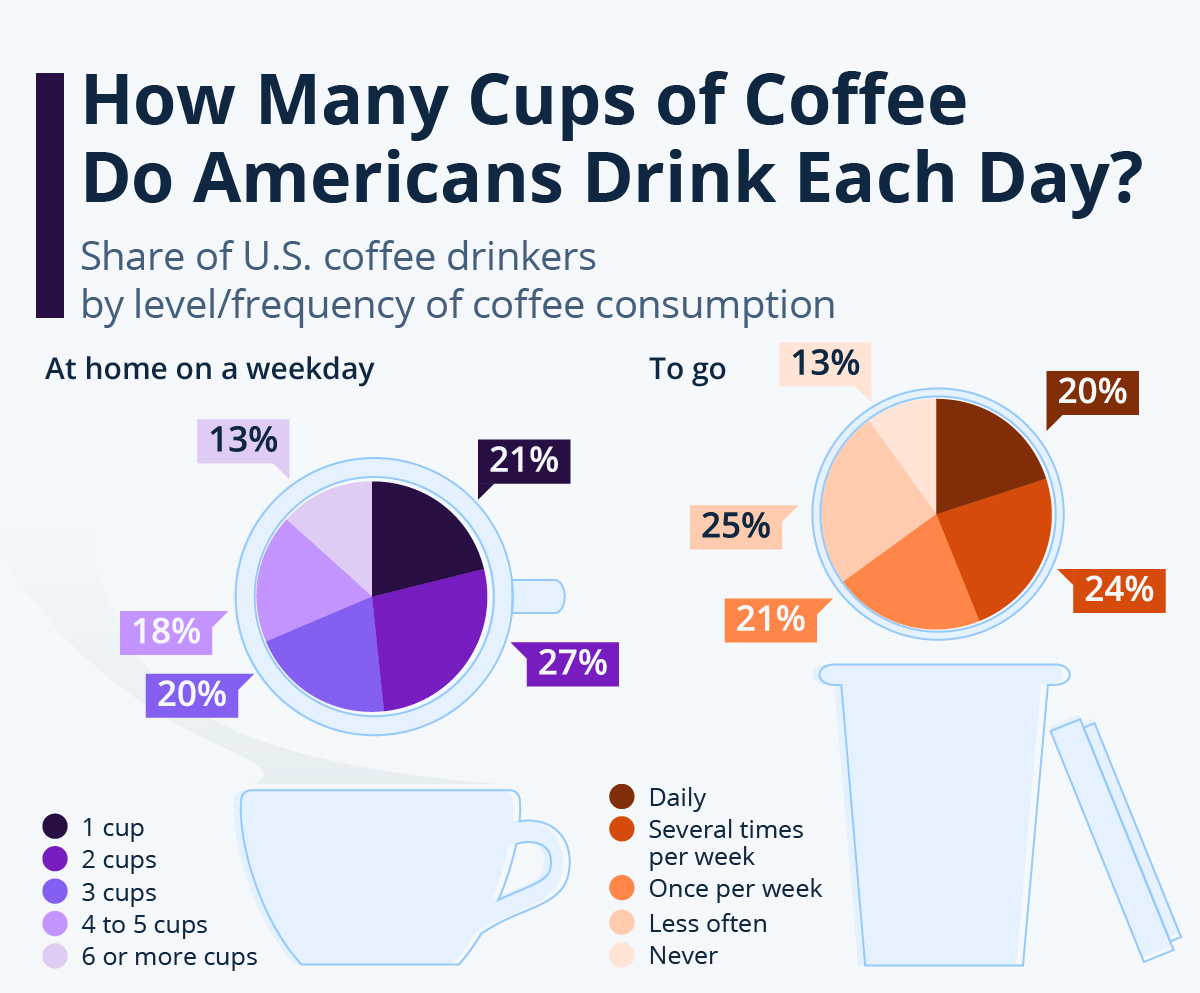
- According to a Statista Consumer Insight survey report issued in 2017, most coffee drinkers don’t stop at one cup a day in the U.S.
- Almost 80% of Americans who drink coffee every day have at least two cups at home during the week, and more than half consume three or more cups during an average weekday.
- On the contrary, people seem to be more restrained when it comes to on-the-go coffee; roughly 20% of Americans drink takeaway coffee daily, while another 24% do so several times a week.
- More than 50% said they usually have take-away coffee only once a week or less, with 13% of people ages 18 to 74 saying they never buy coffee to-go at all.
- Interestingly, a newer Statista survey, however, found out that less than 60% of Americans admitted to regularly drinking coffee, specifically 57%.
- As for favourite types of coffee, 36% of Americans choose plain, traditional drip coffee.
- It is followed by an 11% preference for cappuccino, while iced coffee takes 10% of these preferences, and instant coffee steals away 9%. Additionally, 51% of American adults perceive coffee as an absolute joy.
Coffee Consumption By Region
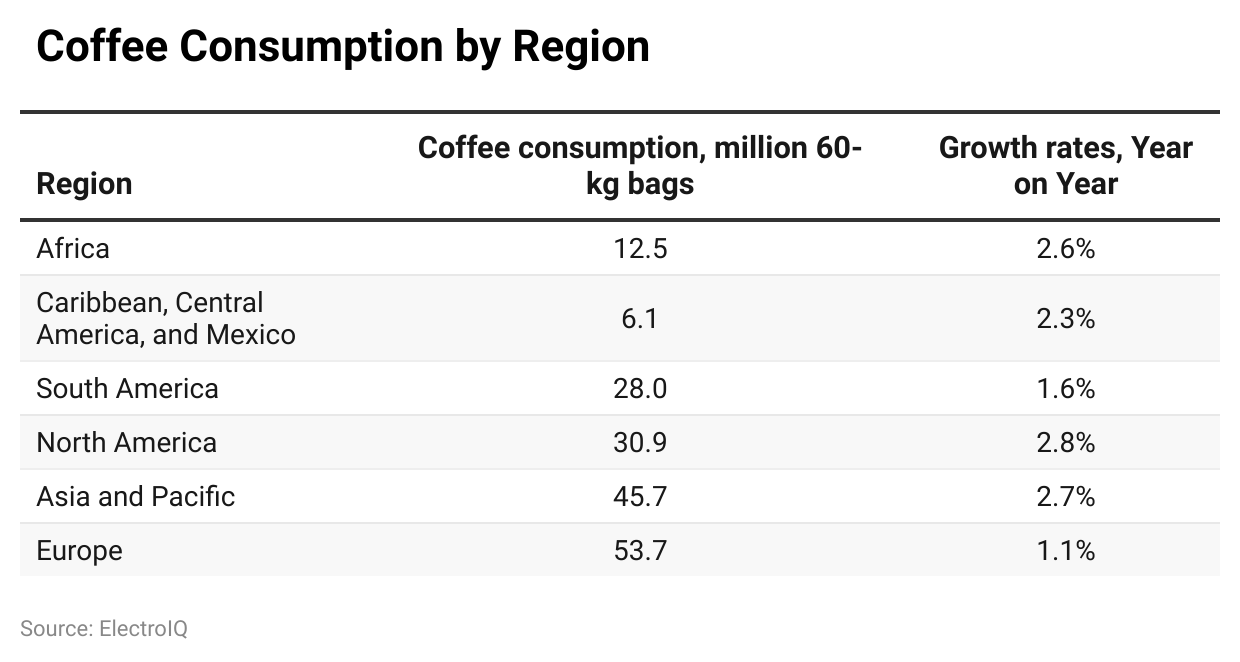
- Coffee drinkers differ by volume and growth from one region to another. Europe consumes the most coffee in the world, a total of 53.7 million 60-kg bags, with a decent growth rate of 1.1% per annum.
- Asia and the Pacific come second with 45.7 million bags and a more promising rate of growth of 2.7%.
- North America is ranked third with 30.9 million bags, growing at about 2.8% faster, which clearly indicates the steady increase in demand.
- South America consumes about 28 million bags, growing at a rate of 1.6%.
- Africa is placed with 12.5 million bags but is growing at 2.6%, whereas the Caribbean, along with Central America and Mexico, consume 6.1 million bags with a 2.3% growth rate.
- These figures show that while Europe remains the top consumer, regions like Asia-Pacific and North America are seeing stronger growth trends in coffee demand.
Favorite Coffee Brands
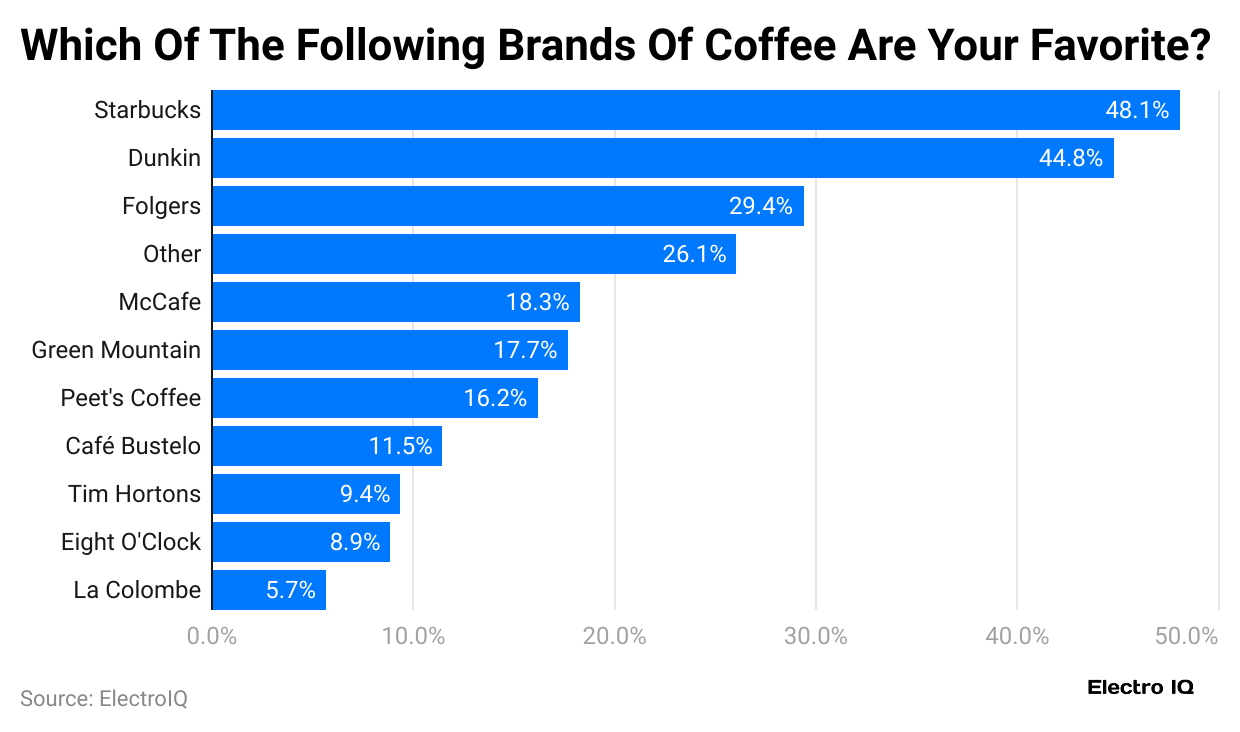
- In a 2023 U.S. survey, Starbucks emerged as the most popular coffee brand, selected by a significant portion of respondents.
- Following Starbucks, Dunkin’ and Folgers were also favoured, although they received a smaller percentage of the votes.
- In terms of overall coffee consumption, Americans consume more than 26 million 60-kilogram bags of coffee annually.
- Over the past decade, this number has increased slightly, with current figures showing that Americans are drinking around 3 million more 60-kilogram bags than they did in 2013.
- Speciality coffee drinks, including ready-to-drink options, are the most commonly consumed types of coffee in the United States and are enjoyed by a large share of consumers.
- Espresso-based beverages—like cappuccinos, lattes, café mochas, espressos, macchiatos, and Americanos—are consumed by about 25% of Americans.
- When looking at frequency, more than 60% of Americans drink coffee daily, showing how deeply coffee is embedded in everyday routines.
- These statistics indicate that although Europe remains the chief market for consumption, the demand for coffee in regions such as Asia-Pacific and North America is gaining more momentum.
Country With High Coffee Consumers
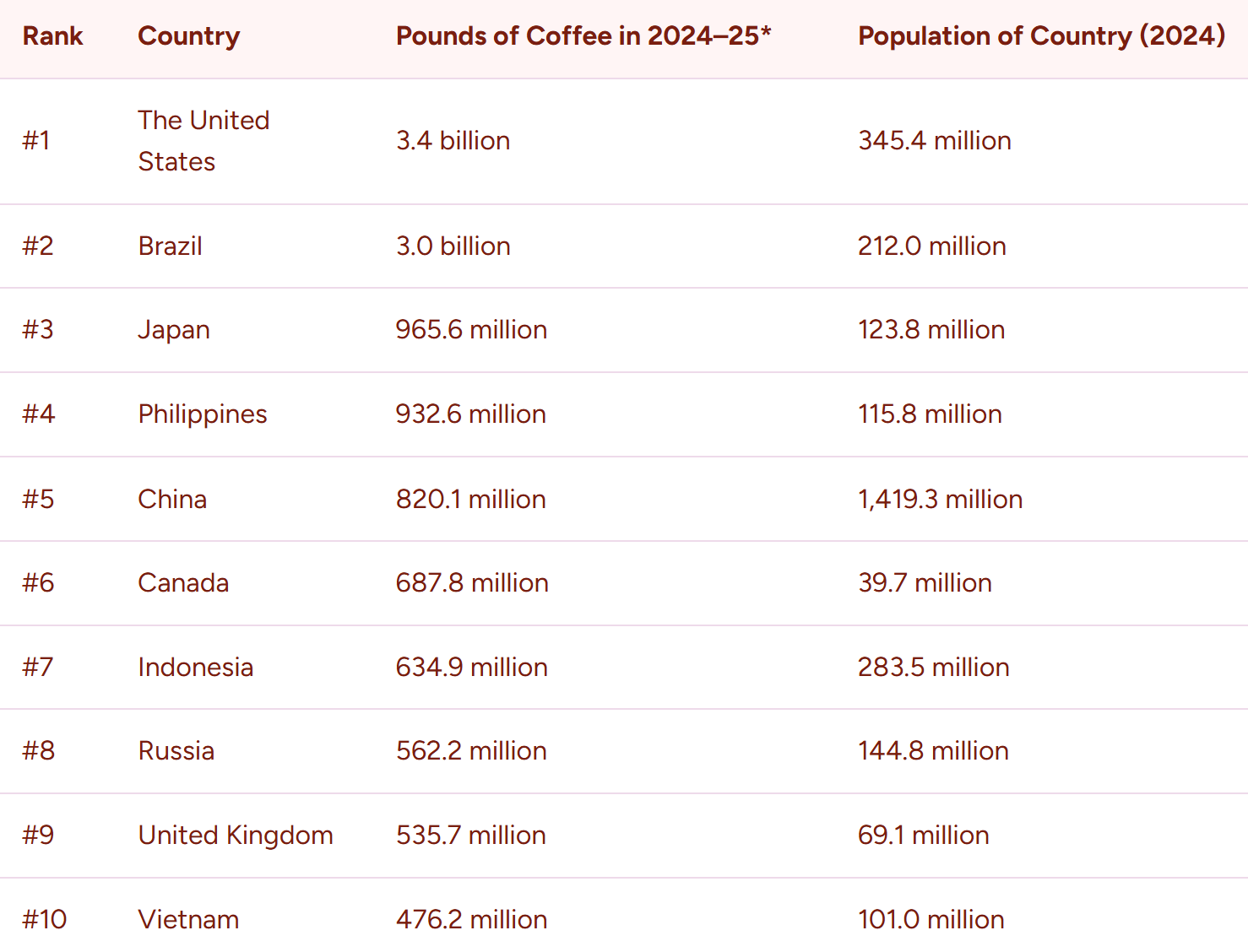
- In 2024–25, the USA would become the largest coffee-consuming country, with an expected consumption of approximately 3.4 billion pounds.
- With a population nearing 345.4 million, it means that the per capita coffee consumption is also correspondingly high.
- Brazil comes second in consumption, with about 3.0 billion pounds, with a population of 212 million, confirming that the country has a strong coffee culture as well as being a prime producer of coffee.
- Japan, occupying the third position in the ranks, consumes about 965.6 million pounds of coffee among its 123.8 million inhabitants.
- It is closely followed by the Philippines, where an estimated 932.6 million pounds of coffee will be consumed among 115.8 million people.
- For all its bigness of population, standing around 1.42 billion, China comes fifth, with a consumption of 820.1 million pounds of coffee, indicating that although coffee is gaining its way into a new area, it is still overshadowed by tea in cultural preference.
- Canada, on the other hand, with only 39.7 million people, consumes 687.8 million pounds of coffee, putting it among the top ones in per capita coffee consumption.
- Indonesia ranks next with 634.9 million pounds of coffee consumption among 283.5 million people.
- Russia takes the next space at 562.2 million pounds with 144.8 million people, and the United Kingdom nearly walks a tie with 535.7 million pounds of coffee consumption among 69.1 million people.
- The tenth position is taken by Vietnam, where about 476.2 million pounds of coffee are consumed by 101 million people.
- The numbers around indicate cultural preferences and population size as the prime movers in determining coffee consumption across the globe.
Coffee Consumption Frequency
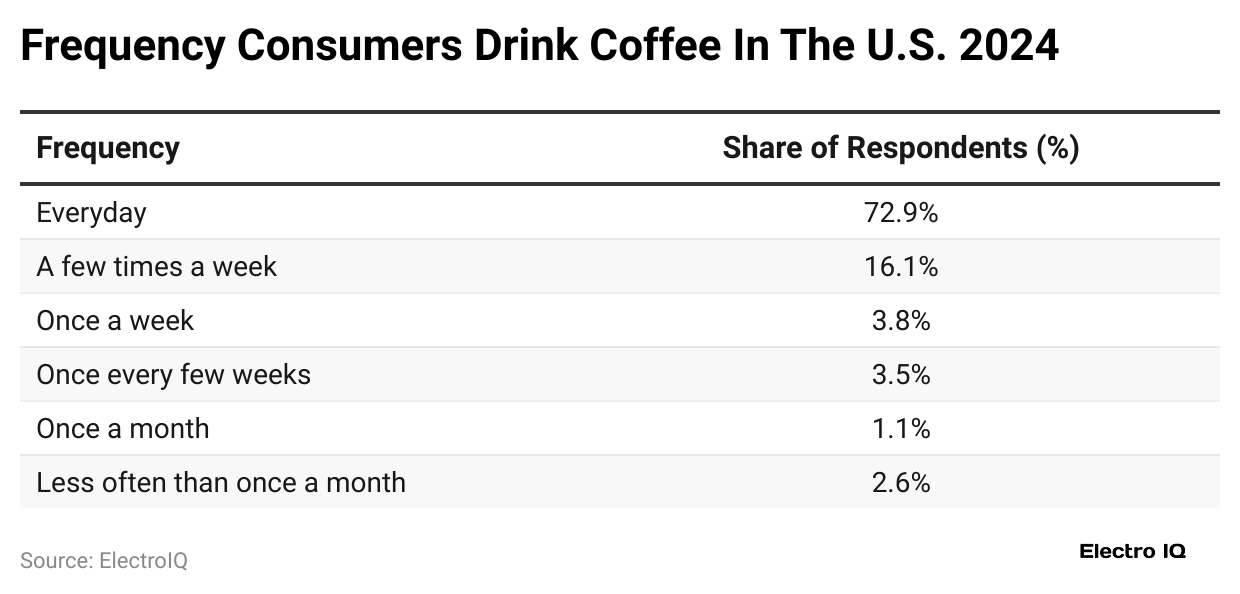
- The statistics derived from Drive Research show that drinking coffee is a huge commonality among Americans in 2024. From this huge 72.9% share of the population drinking coffee daily, one can see how coffee has been embedded into the daily lives of millions of people.
- Another 16.1% stated that they would drink the beverage a few times each week, pointing to regular consumption but not on a daily basis.
- In comparison, 3.8% of respondents would have a cup every week, while 3.5% said every few weeks. Only 1.1% reported having coffee about once a month, and 2.6% drank it even less often.
Coffee Consumption Per Day

- A Drive Research survey conducted in 2024 found that 73% of Americans drink coffee daily, signifying the mass liking for the beverage.
- Among everyday drinkers of the beverage, about 60% drink 1 to 2 cups daily, 36% drink 3 to 5 cups daily, and only 4% drink more than 6 cups a day.
- These figures show that the drink is immensely popular across the U.S., but that there is considerable variation in how many people drink coffee.
Preferred Ways of Making Coffee By Generation
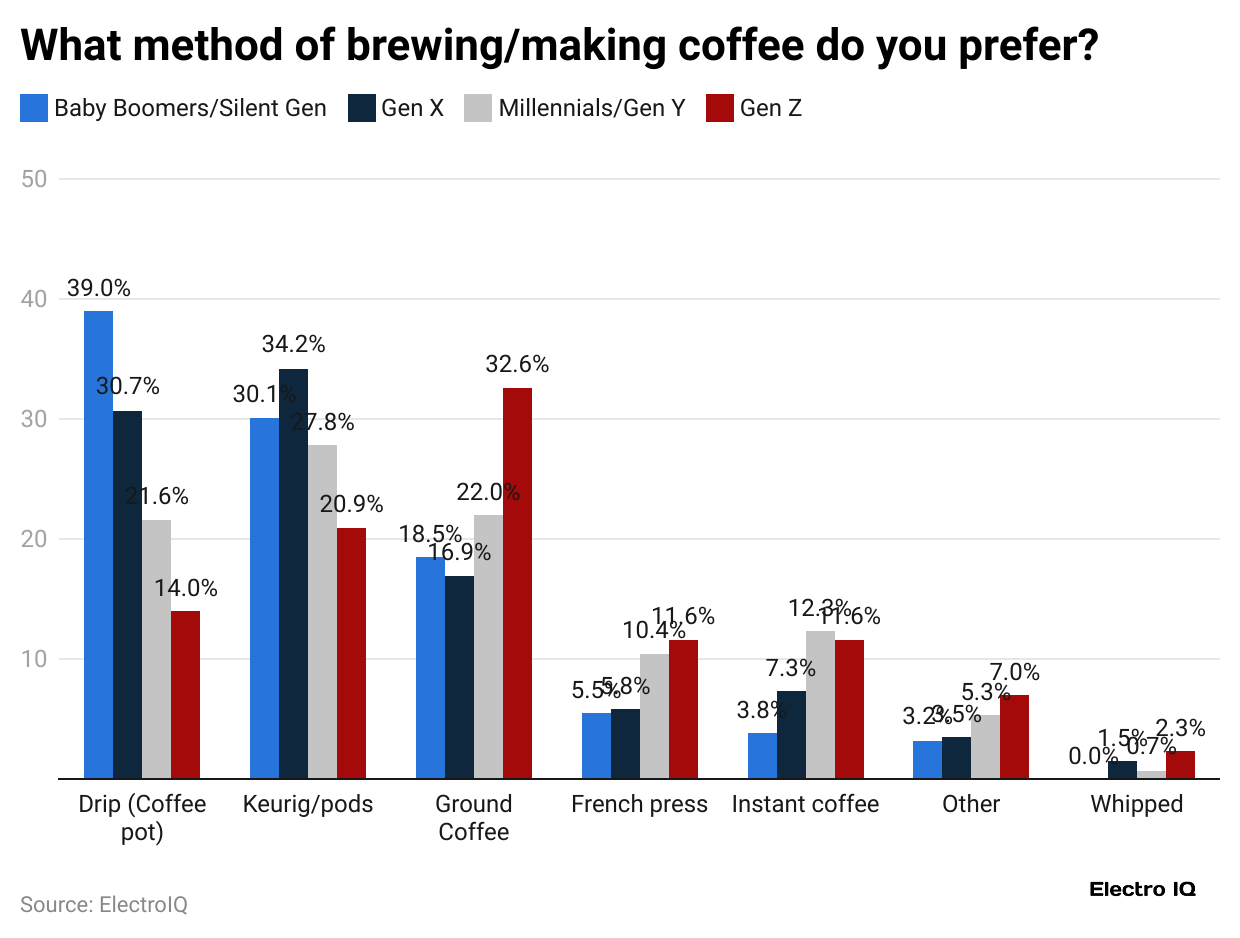
- U.S. generations tend to differ with respect to coffee-brewing preferences. Baby Boomers tend to go for methods of drip coffee, reflecting their interest in more traditional brewing methods.
- Generation Xers tend to use Keurig or pods for coffee, which translates to a preference for convenience and easy single-serve options.
- Generation Z prefers to experiment with trendy methods such as the French press or whipping coffee, with their choices highlighting their preference for unique and creative experiences.
- Conversely, millennials typically favour instant coffee, their time and efficiency in everyday life being more of a priority.
Global Coffee Production
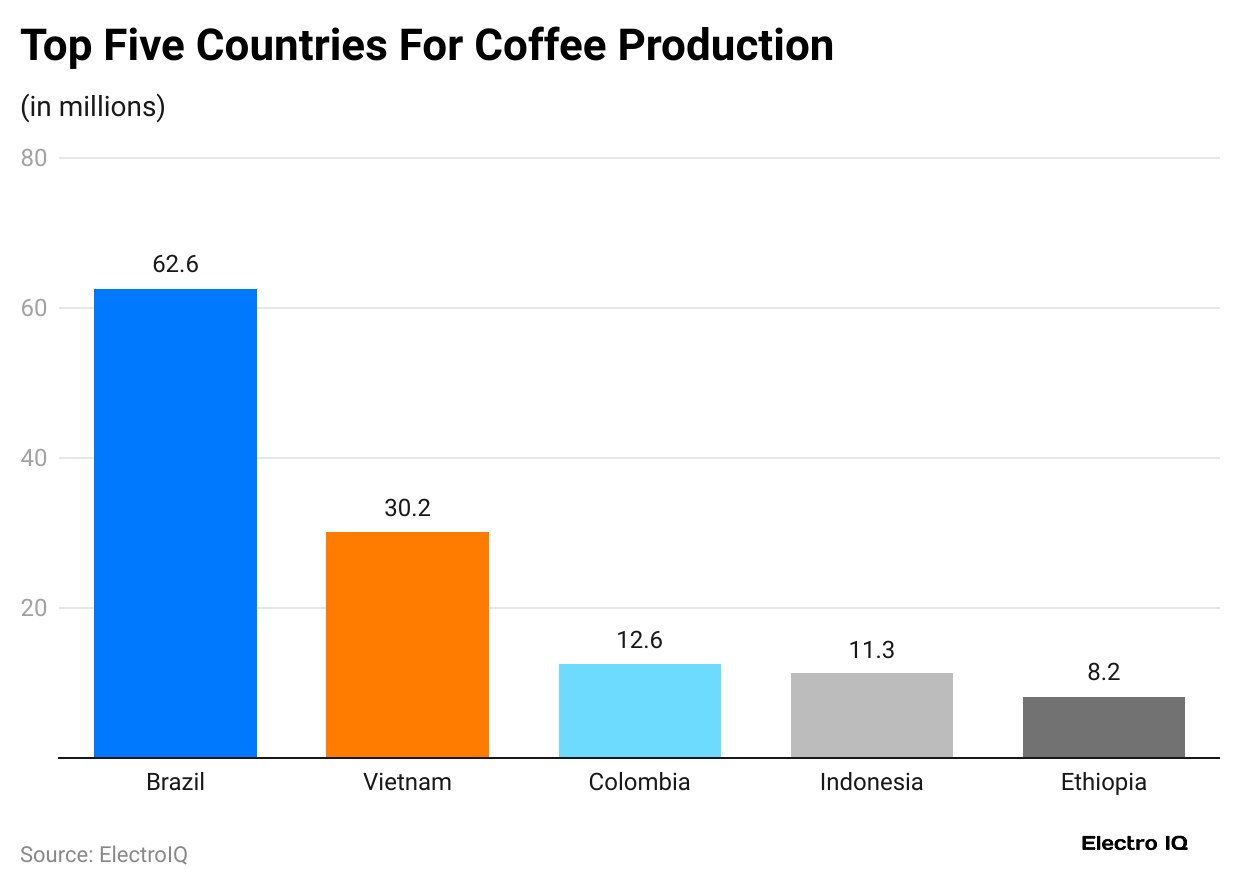
- If the messenger bears good news, it speaks well for Brazil being the largest coffee producer in the world, as 62.6 million bags, each weighing 60 kilograms, were produced during 2022. It produces well beyond any other country.
- Vietnam comes second in production with 30.2 million bags and is followed by Colombia with 12.6 million.
- Indonesia, with 11.3 million bags, took fourth place, and then came Ethiopia with 8.2 million bags.
- The other important producers are Uganda, 6.6 million bags, India, 6.2 million, Honduras 6 million, Peru, 4.2 million, and Mexico, 3.8 million.
- From the selling viewpoint, coffee is dominated by Brazil, but there are still many countries that play an important part in the global supply picture.
Global Coffee Spending
- Making coffee is like a daily ritual for some, while it really costs something. 11% of those who brew coffee at home will spend above US$40 per month.
- More people, that is, 31%, will spend from US$11 up to US$20. Only 6% of those spending under US$40 are made up of college kids, whereas 36% of new parents make up the majority in spending, with about US$40.
- Some other common levels of spending are as follows: 25% spend between US$21 and US$30, 15% spend US$31 to US$40, and 13% say they spend less than US$10 monthly.
- On the other hand, buying coffee from a coffee shop tends to be on the more frequent side, with 51% buying at least once a week. 7% never buy coffee from a coffee shop, to be slightly more specific. 8% of Americans buy their coffee daily on the go. 27% go to the coffee shop a couple of times each week.
- 16% go once a week, and 17% purchase once every few weeks. An additional 8% are just monthly buyers, while 17% buy even less than that.
- In particular, new parents are quite frequent coffee shop customers. A reported 67% say they buy their coffee at least once per week, and a staggering 49% report buying coffee more than once a week.
- As for how much they spend at cafes or coffee shops monthly, the majority are in the US$20 or less range, totalling approximately 54%.
- Then, 16% spend between US$21 and US$30, with 12% spending US$31 to US$40, while 14% spend more than US$40 per month.
- The numbers serve as testimony to the fact that coffee consumption habits are as diverse as the different groups and lifestyles.
Consumption of Coffee-Based Drinks/Dishes
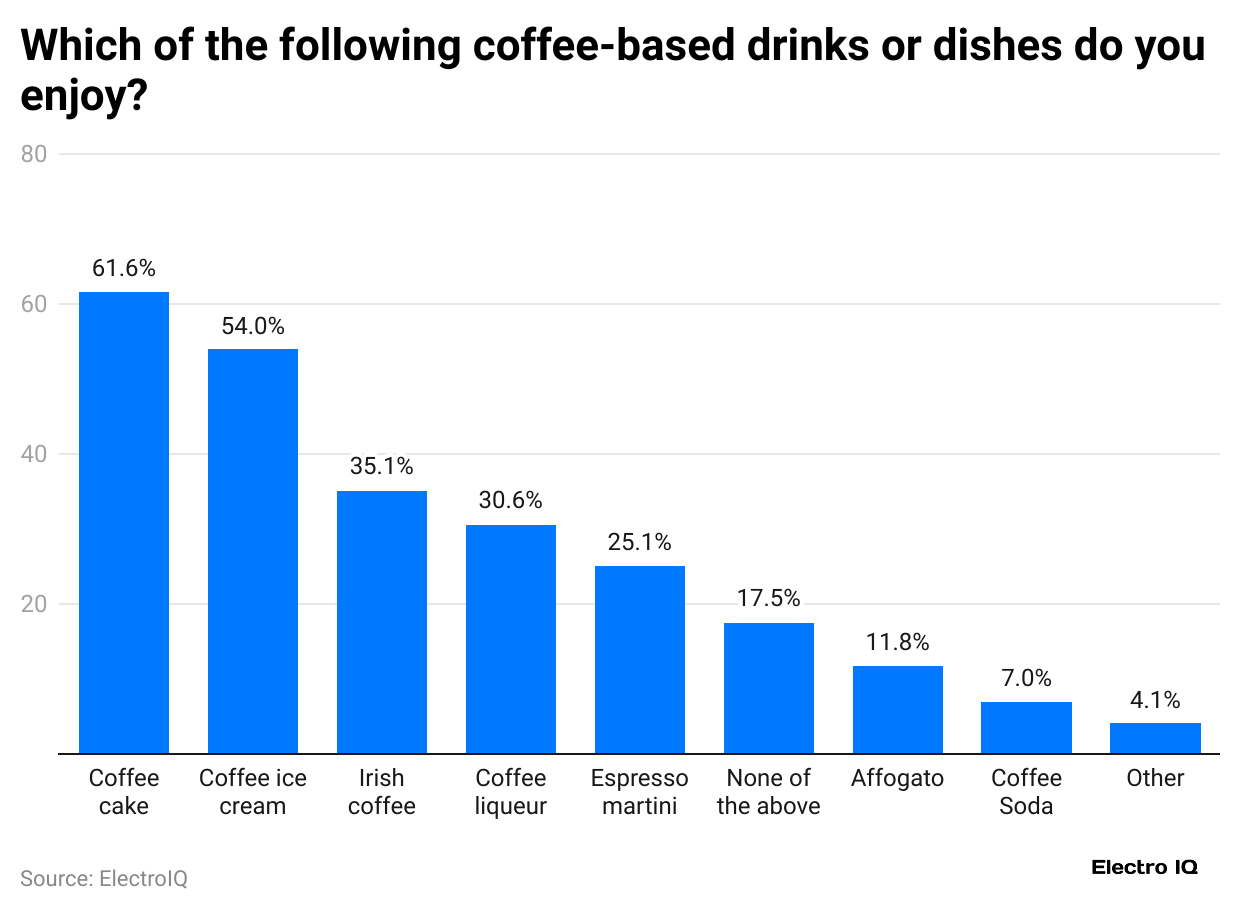
- Among coffee foods and drinks, coffee cake holds the top spot in the preferences of American coffee lovers, the most popular dish with any kind of coffee presence.
- Coffee ice cream is greatly admired as well, with 54% of respondents naming it among their preferred coffee-flavoured treats.
- Irish coffee, in the traditional endless mix of coffee and whiskey, is next, with 35.1% of people stating that they enjoy it.
- Other popular alternatives for coffee-based drinks include coffee liqueur and espresso martinis, which present a boozy yet classy spin to coffee flavours.
- Affogato is a hot and cold dessert that blends hot and cold with hot espresso poured over a scoop of ice cream.
- Also gaining traction are coffee sodas, offering a bubbly, refreshing alternative for those wanting to have their coffee a little differently.
Average Coffee Price
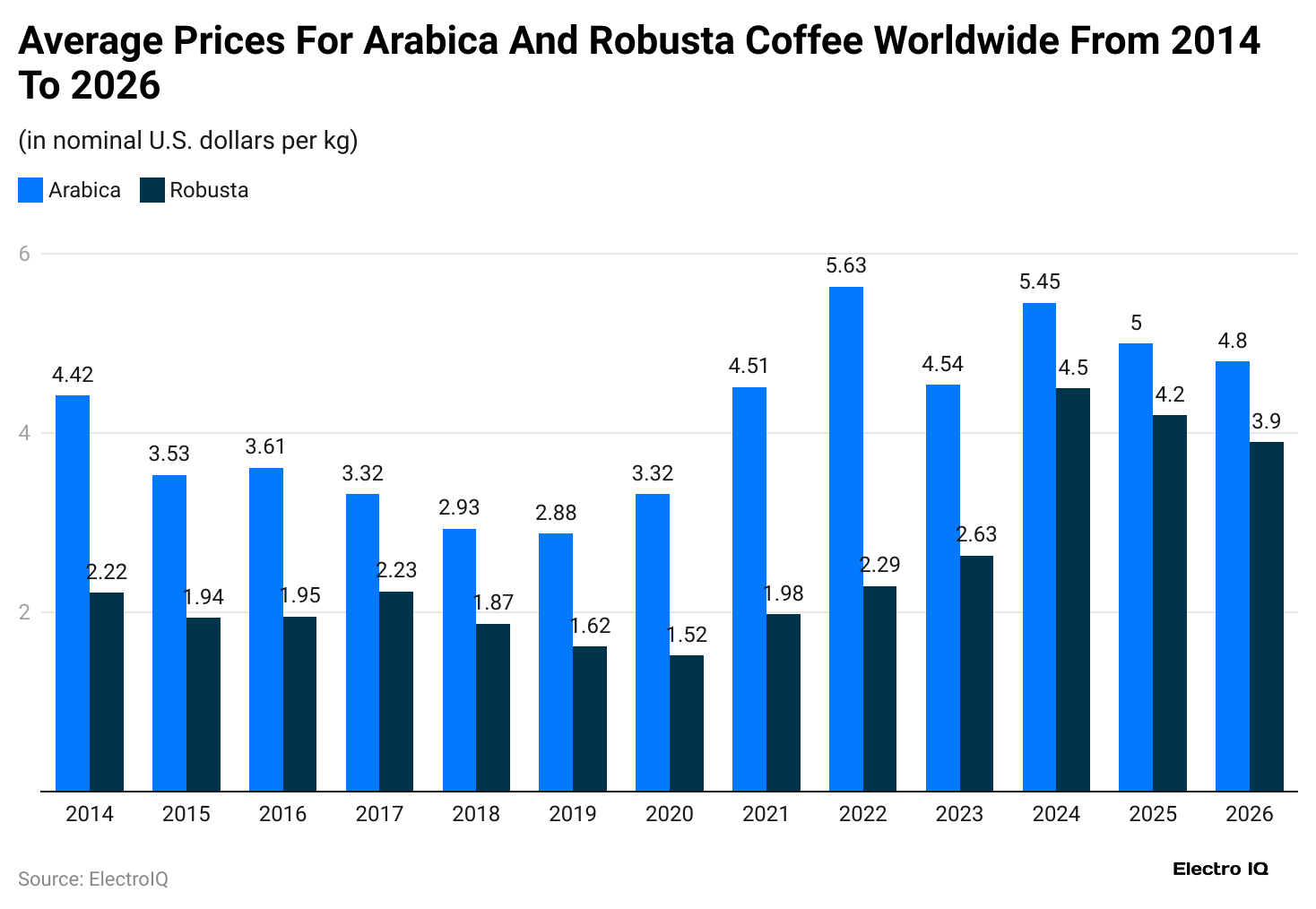
- Coffee growers grow mainly two varieties of coffee beans: Arabica and Robusta. Arabica is relatively more expensive, fetching about US$2.93 per kilogram in 2018, with projections pointing up to US$4.80 by 2026.
- Robusta is more versatile in growing conditions and altitudes, priced at US$1.87 per kilogram in 2018 and expected to touch US$3.90 in 2026.
- The history of coffee starts in Ethiopia, which is a giant in the sphere of world coffee production.
- The more popular variety, Arabica, derives its name from the Arabian Empire, through which coffee drinking had spread through the Middle East. In Europe, where the per capita consumption of coffee is now highest, the beverage initially had a stormy passage, being banned by the Catholic Church as an intoxicant and symbol of the Muslim world.
- Starbucks played a major role in developing coffee culture by capitalising on the coffee scene in Seattle. It was a force to mainstream gourmet coffee, thus changing global demand from the cheaper Robusta beans to the more flavorful Arabica beans.
- That change in preference has also prompted several other companies, such as McDonald’s, to adapt their brand with the launch of McCafé outlets to cash in on this burgeoning demand for better coffee.
Conclusion
How Many People Drink Coffee: Coffee has continued to be an essential part of daily life throughout the world for billions of people. With over a billion drinking it daily and over 2.25 billion cups being consumed every day, such importance can never be undermined.
While the likes of Finland and Luxembourg are in the lead when it comes to per capita consumption, the emerging markets such as India have a huge growth potential. As the tastes of consumers mature and the global market confronts new challenges, coffee will remain a resilient and popular beverage.
FAQ.
It is estimated that one billion people around the world drink coffee on a daily basis, with each drinking more than 2.25 billion cups daily. In some places, coffee is seen not merely as a beverage but as a culture that is growing fast with the changing lifestyle, urbanisation, and speciality requirements of on-the-go coffee.
When we detail the specifics, the common coffee-making preferences change from one generation to another. Baby boomers mostly work with drip-style coffee makers, whereas Generation X generally finds convenience in using Keurig and other pod-based systems. Instant is very popular with Millennials, who appreciate its speed and efficiency. Lastly, Generation Z is all about the French press and cool modern styles like whipped coffee.
The United States leads the world in coffee consumption, with an estimated 3.4 billion pounds of coffee consumption for the years 2024-25. The United States really does not consume coffee the most per capita, whereas it ranks first due to its large population and very deeply ingrained coffee culture. Brazil, Japan, and the Philippines all have high levels of coffee consumption in such rankings.
From a 2023 survey, Starbucks ranks first in popularity for coffee brands in the United States, followed by Dunkin’ and Folgers. Unparalleled accessibility, particularly branding, and some speciality products are some reasons Starbucks stands out from all the others. These brands have managed to hold breakfasts for the American coffee market, which is just shy of US$95 billion each year.
The amounts spent on coffee vary widely. Some 31% of people say they spend from US$11 to US$20 monthly on coffee brewed at home, while 51% of Americans buy coffee from a café at least once a week. As far as café spending, most people, around 54%, spend US$20 or less a month, although 14% report that they spend over US$40. New parents seem to be in the biggest group of spenders when it comes to purchasing their coffee, with almost half of them purchasing coffee more than once a week.

Joseph D'Souza founded ElectroIQ in 2010 as a personal project to share his insights and experiences with tech gadgets. Over time, it has grown into a well-regarded tech blog, known for its in-depth technology trends, smartphone reviews and app-related statistics.





